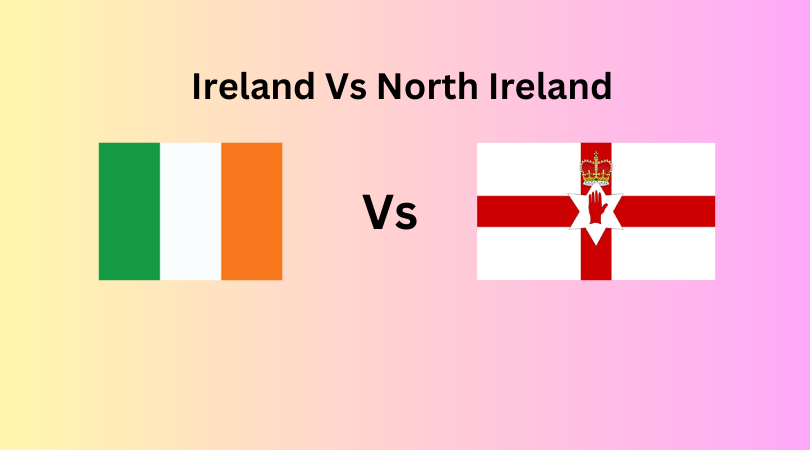The roots of the rivalry between Northern Ireland and Ireland run deep into the annals of history. The division between these two territories can be traced back to the early 20th century when Ireland was partitioned, creating Northern Ireland as a separate entity within the United Kingdom. This division was primarily based on religious and political differences, with Northern Ireland predominantly Protestant and aligned with the UK, while Ireland was mainly Catholic and sought independence.
Despite their geographical proximity, Northern Ireland and Ireland took divergent paths in terms of governance and identity. The legacy of British colonization and the struggle for Irish independence further fueled tensions between the two regions, shaping their distinct cultural and political landscapes. These historical dynamics continue to influence the relationship between Northern Ireland and Ireland to this day, contributing to a complex and multifaceted rivalry.
The aftermath of partition saw Northern Ireland becoming a part of the UK, leading to a period of conflict and unrest known as “The Troubles.” The Troubles, which lasted for decades, pitted nationalist and unionist communities against each other, resulting in violence and deep-seated animosities. This turbulent period left a lasting impact on the psyche of both regions, further solidifying their separate identities and fueling the rivalry between Northern Ireland and Ireland.
Cultural Differences Between Northern Ireland and Ireland
The cultural differences between Northern Ireland and Ireland are evident in various aspects of daily life, reflecting the divergent histories and influences that have shaped these regions. One of the most prominent cultural distinctions lies in the realm of language, with English and Irish (Gaelic) being the official languages in Northern Ireland and Ireland, respectively. This linguistic variance underscores the unique cultural identities of each region and serves as a reminder of their historical trajectories.
Religion also plays a significant role in defining the cultural landscapes of Northern Ireland and Ireland, with Protestantism and Catholicism serving as dominant faiths in the respective regions. This religious divide has not only influenced social dynamics but has also contributed to shaping political allegiances and identities. The legacy of religious differences continues to influence cultural practices, traditions, and societal norms in Northern Ireland and Ireland, adding layers of complexity to their relationship.
Beyond language and religion, the cultural differences between Northern Ireland and Ireland extend to music, literature, art, and cuisine. Each region boasts a rich cultural heritage that reflects its unique history and influences, showcasing a diverse tapestry of traditions and customs. From traditional Irish folk music to Northern Irish murals depicting political themes, the cultural landscapes of these regions offer a glimpse into their distinct identities and narratives, highlighting the richness of their heritage.
Political Differences Between Northern Ireland and Ireland
The political landscape of Northern Ireland and Ireland is characterized by divergent ideologies, historical grievances, and competing visions of governance. Northern Ireland’s status as a constituent part of the UK positions it within the broader framework of British politics, with unionist and nationalist parties representing contrasting views on the region’s constitutional future. The legacy of partition and the Troubles continue to shape political discourse in Northern Ireland, influencing debates on issues such as identity, sovereignty, and reconciliation.
In contrast, Ireland’s political landscape is shaped by its status as an independent republic, with a focus on national sovereignty, economic development, and social progress. The country’s history of struggle for independence from British rule has left a lasting imprint on its political institutions and policies, guiding its approach to issues such as European integration, human rights, and cultural preservation. The political differences between Northern Ireland and Ireland reflect not only divergent historical trajectories but also competing visions of identity and nationhood.
The relationship between Northern Ireland and Ireland is further complicated by the broader context of British-Irish relations and the complexities of Brexit. The decision of the UK to leave the European Union has raised concerns about the impact on the border between Northern Ireland and Ireland, reigniting debates about sovereignty, trade, and identity. The political differences between Northern Ireland and Ireland are thus situated within a dynamic and evolving geopolitical landscape, shaped by historical legacies and contemporary challenges.
The Troubles and Its Impact on the Rivalry
The Troubles, a period of conflict and violence in Northern Ireland that lasted from the late 1960s to the late 1990s, had a profound impact on the rivalry between Northern Ireland and Ireland. Rooted in historical grievances, political divisions, and social inequalities, the Troubles exacerbated tensions between nationalist and unionist communities, leading to widespread violence and loss of life. The legacy of this turbulent period continues to shape perceptions and attitudes in both regions, influencing their interactions and identities.
The Troubles not only deepened the divide between Northern Ireland and Ireland but also had far-reaching implications for the broader British-Irish relationship. The conflict drew international attention and raised questions about human rights, political representation, and the role of external actors in resolving internal conflicts. The complex dynamics of the Troubles highlighted the deep-seated divisions within Northern Ireland and Ireland, underscoring the challenges of reconciliation and peacebuilding in a deeply divided society.
Despite the formal end of the Troubles with the signing of the Good Friday Agreement in 1998, the legacy of this period continues to reverberate in the political, social, and cultural spheres of Northern Ireland and Ireland. The scars of the conflict remain visible in the physical landscape, the memory of those who lost their lives, and the ongoing efforts to address the legacies of violence and trauma. The impact of the Troubles on the rivalry between Northern Ireland and Ireland serves as a poignant reminder of the enduring consequences of division and conflict.
Sporting Rivalries Between Northern Ireland and Ireland
Sport has long been a powerful tool for expressing identity, fostering community spirit, and fueling rivalries between nations. The sporting rivalries between Northern Ireland and Ireland are no exception, with passionate fans and historic clashes adding another layer of complexity to their relationship. Football, rugby, and Gaelic games are among the most popular sports in both regions, serving as platforms for competition, camaraderie, and cultural expression.
In football, the rivalry between Northern Ireland and Ireland has produced memorable encounters on the international stage, with matches between the two teams evoking strong emotions and national pride. The historic significance of these games goes beyond the sporting realm, reflecting deeper political and cultural divisions that have defined the relationship between Northern Ireland and Ireland. The sporting rivalry serves as a microcosm of the broader tensions and allegiances that shape the identities of both regions.
Rugby also plays a significant role in the sporting rivalry between Northern Ireland and Ireland, with the respective national teams competing in the Six Nations Championship and other international tournaments. The passion and intensity of these matches mirror the complex relationship between the two regions, highlighting the shared heritage and divergent paths that have shaped their identities. Through sporting rivalries, Northern Ireland and Ireland find a unique outlet for expressing their competitive spirit and cultural distinctiveness, adding an exciting dimension to their historic feud.
Tourism and Attractions in Northern Ireland and Ireland
Northern Ireland and Ireland are renowned for their rich cultural heritage, stunning landscapes, and vibrant cities, making them popular destinations for tourists from around the world. From the iconic Giant’s Causeway in Northern Ireland to the historic city of Dublin in Ireland, the two regions offer a diverse array of attractions that showcase their unique histories and natural beauty. Tourists flock to Northern Ireland and Ireland to explore ancient castles, picturesque villages, and bustling markets, immersing themselves in the rich tapestry of traditions and customs that define these regions.
In Northern Ireland, visitors can marvel at the rugged beauty of the Causeway Coast, visit the historic walls of Derry/Londonderry, or explore the enchanting landscapes of the Mourne Mountains. The region’s cultural attractions, such as the Titanic Belfast museum and the Ulster Folk Museum, offer insights into its rich heritage and complex history. Northern Ireland’s vibrant arts scene, bustling markets, and welcoming locals make it a must-visit destination for travelers seeking a blend of history, culture, and natural beauty.
In Ireland, tourists are drawn to the vibrant city of Dublin, with its lively pubs, historic landmarks, and literary heritage. The country’s stunning countryside, including the Cliffs of Moher, the Ring of Kerry, and the Burren, captivates visitors with its raw beauty and ancient mystique. Ireland’s rich cultural offerings, from traditional music sessions to ancient castles, provide a glimpse into its unique identity and storied past. Whether exploring the bustling streets of Dublin or the serene landscapes of the countryside, visitors to Ireland are sure to be enchanted by the warmth of its people and the richness of its culture.
Reconciliation Efforts Between Northern Ireland and Ireland
In the aftermath of the Troubles and amid ongoing political tensions, efforts to promote reconciliation and foster peace between Northern Ireland and Ireland have gained momentum. Various initiatives, both at the grassroots and governmental levels, aim to bridge divides, heal wounds, and build trust between communities in the two regions. The Good Friday Agreement, signed in 1998, laid the foundation for peace and reconciliation in Northern Ireland, establishing power-sharing arrangements and addressing key issues such as human rights, justice, and policing.
Beyond formal agreements, community-based organizations and peacebuilding initiatives play a crucial role in promoting understanding and dialogue between Northern Ireland and Ireland. Projects that bring together people from different backgrounds, foster cross-community cooperation, and address the legacies of conflict help to build bridges and promote reconciliation. Cultural exchanges, educational programs, and commemorative events also contribute to fostering mutual respect and understanding, paving the way for a more harmonious relationship between the two regions.
While challenges remain and deep-seated divisions persist, the efforts to promote reconciliation between Northern Ireland and Ireland offer hope for a brighter future. By acknowledging the past, addressing grievances, and working towards shared goals, communities in both regions can move towards a more peaceful and inclusive society. The commitment to reconciliation reflects a shared aspiration for a better tomorrow, one marked by understanding, cooperation, and respect for diverse identities and perspectives.
The Future of the Northern Ireland-Ireland Relationship
As Northern Ireland and Ireland navigate the complexities of a changing world, the future of their relationship remains a topic of speculation and debate. The challenges posed by Brexit, shifting political dynamics, and evolving social attitudes have the potential to reshape the dynamics between the two regions, presenting new opportunities for cooperation and engagement. The need for dialogue, understanding, and shared vision has never been more crucial as Northern Ireland and Ireland seek to navigate the complexities of their historic rivalry and forge a path towards a more peaceful and prosperous future.
The ongoing efforts to promote reconciliation, address historical grievances, and build bridges between Northern Ireland and Ireland offer a glimmer of hope for a more harmonious relationship. By acknowledging the complexities of their shared history, embracing cultural diversity, and fostering mutual respect, the two regions can chart a course towards a future marked by cooperation, understanding, and shared prosperity. The commitment to dialogue, inclusivity, and reconciliation will be key in shaping the future of the Northern Ireland-Ireland relationship, paving the way for a more peaceful and interconnected society.
As Northern Ireland and Ireland continue to grapple with the legacies of the past and the challenges of the present, the road ahead is fraught with uncertainty and possibility. By embracing their shared heritage, celebrating their cultural diversity, and seeking common ground, the two regions can forge a path towards a future defined by cooperation, harmony, and mutual respect. The future of the Northern Ireland-Ireland relationship holds the promise of a brighter tomorrow, one shaped by reconciliation, understanding, and a shared commitment to building a more inclusive and peaceful society.
Conclusion
Celebrating the Diversity and Shared Heritage of Northern Ireland and IrelandIn the tapestry of history, the rivalry between Northern Ireland and Ireland stands out as a complex and multifaceted tale of division and unity, conflict and cooperation. From their divergent political paths to their shared cultural heritage, these two regions offer a rich tapestry of traditions, customs, and identities that reflect the nuances of their relationship. As we explore the cultural, political, and sporting differences between Northern Ireland and Ireland, we uncover the layers of complexity and depth that define this historic feud.
Despite the challenges and tensions that have marked their relationship, Northern Ireland and Ireland share a common bond forged through centuries of shared history, struggle, and resilience. The richness of their cultural landscapes, the vibrancy of their communities, and the warmth of their people speak to a shared heritage that transcends political divides and geographical boundaries. By embracing their diversity, acknowledging their differences, and celebrating their commonalities, Northern Ireland and Ireland can pave the way for a future built on understanding, cooperation, and mutual respect.
As we reflect on the historic rivalry between Northern Ireland and Ireland, let us not only recognize the complexities and challenges that have shaped their relationship but also celebrate the resilience, creativity, and spirit of their people. The journey towards reconciliation, peace, and unity is a collective endeavor that requires openness, dialogue, and a shared commitment to building a better tomorrow. Through understanding, empathy, and cooperation, Northern Ireland and Ireland can transcend the shadows of the past and embrace a future filled with hope, harmony, and mutual prosperity.



This text provides a deep dive into the historical and cultural complexities between Northern Ireland and Ireland, which is both fascinating and thought-provoking. It’s intriguing how such close neighbors can develop such distinct identities, shaped by centuries of colonization and conflict. The emphasis on language as a cultural marker is particularly striking—it’s amazing how something as fundamental as language can symbolize so much more than just communication. The political landscape, especially the legacy of the Troubles, seems to still cast a long shadow over the region, which makes me wonder how future generations will navigate these tensions. Do you think there’s a possibility for a more unified identity in the future, or will the divisions persist? I’d love to hear your thoughts on how reconciliation can be fostered while still honoring the unique histories of both regions. What role do you think cultural exchange or shared initiatives could play in bridging these divides?